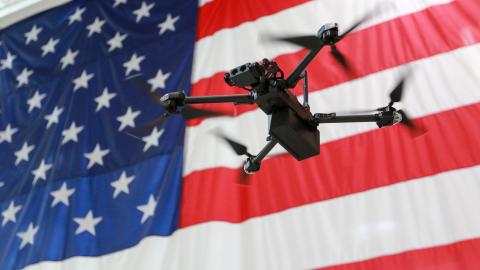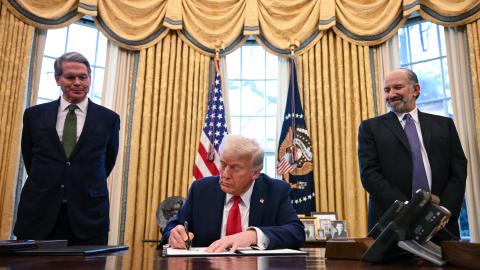The Islamic Republic of Iran never seems to entirely disappear from international news. Some of this is due to the uproar over US President Donald Trump’s rejection of the Joint Comprehensive Plan of Action and his administration’s efforts to quell Iranian misbehavior through economic sanctions.
Those who oppose the US sanctions on principle may be unaware of the severity of the regime’s misdeeds, since much of the Islamic Republic’s malicious activity is concealed.
For instance, last year Israeli agents exposed an Iranian warehouse overflowing with undeniable evidence of deadly intentions. They somehow managed to seize and export thousands of notes, reports and graphs, documenting comprehensive development of nuclear weaponry. It had all been carefully hidden – until it wasn’t.
Meanwhile, Iran’s bloody fingerprints continue to appear in various conflicts in Syria, Lebanon, Iraq, Yemen and beyond. And its tireless attempts to assault Israel continue, primarily acted out through proxies like Hamas and Islamic Jihad – not to mention Hezbollah, whose secret tunnels between Lebanon and Israel were recently exposed and destroyed.
Just days ago, Israeli news sources reported a statement by a high-level Hamas authority that Iran had covertly ordered the recent rocket attack that demolished a house north of Tel Aviv, injuring seven people including two infants.
On the other hand, there’s little to hide when Iran boasts of new weaponry, flashy military exercises or battlefield triumphs. In fact, notorious Quds Force Commander Qassem Soleimani has proudly proclaimed Iran’s intentions, “We are witnessing the export of the Islamic Revolution throughout the region. From Bahrain and Iraq to Syria, Yemen and North Africa.”
Indeed, during February’s celebrations of the Islamic Republic’s 40th anniversary, Ayatollah Khamenei, Iran’s supreme leader, declared that the Islamic Revolution had entered its “Second Phase”: a time “of self-development, society-processing and civilization-building of the Islamic Revolution.” This second phase was affirmed by a Qom University spokesman as “the cornerstone of major policy makings in the country.”
In other words, the worst may be yet to come.
Take, for example, Iraq, where Iran’s strategy is one of creeping hegemony. So far it is working well through such tactics as political intimidation, shady financial transactions and armed intrusion.
Iran-backed militias, under the command of the Quds Force, are tormenting minority returnees to their homes – Christian and Yazidi genocide victims. A campaign of intimidation, threats at gunpoint, and cruelty at checkpoints continues unabated. Some who’ve tried to return and resettle in their towns and villages have fled yet again, too traumatized to remain.
Fear and stealth are also wielded like weapons inside Iran itself. Sudden arrests, fierce interrogations and mass executions of political and religious “enemies of the state” are mostly concealed from the world’s eyes.
Baha’is are the largest religious minority in Iran, described by the regime as a “deviant sect,” whose members are “de facto apostates.” According to the US Commission on International Religious Freedom, Baha’is are “the most severely persecuted religious minority in Iran, not recognized by the state, and denied their political, economic, cultural, and religious rights.” It is noteworthy that the Baha’i World Centre is located in Haifa.
Meanwhile, in 2018 Iran was ranked the 9th worst persecutor of Christians in the world. In late 2018, in one week alone, 114 Christians were arrested, affirming a University of Qom propagandist’s claim that “fighting Evangelical Christianity is one of our core issues.”
By Iran’s definition, the term “Evangelical Christians” frequently identifies converts from Islam to Christianity. According to Western experts, there are potentially hundreds of thousands of these converts. They are variously accused of “acting against the regime,” “threatening na-tional security” and, interestingly, of “promoting Zionist Christianity.”
“Zionist Christianity” was explained to me by a former Iranian house church leader. New converts from Islam treasure the Bible – a book most of them have never seen before, and they read it voraciously. There they discover its accounts of the Jews – of the Patriarchs, the Exodus and the journey to the Promised Land. They begin to understand Israel’s existence as a God-given miracle.
For these converts, Islamist chants of “Death to Israel” stir feelings of solidarity with the Jewish people.
Despite its appalling human rights and religious freedom record, Iran continues to be some-what successful in its international outreach, stretching even beyond the Middle East into Afghanistan, Pakistan and several African nations.
However, in recent months, Iran’s mullahcracy is reportedly in dire financial straits, thanks to US-led international sanctions. Hezbollah and Hamas have both complained that their funding has been slashed dramatically. At the same time, the people of Iran are suffering; angry protests about soaring costs of living have erupted in many Iranian cities.
To make matters worse, in recent days massive floods have submerged 25 of Iran’s 31 provinces, and rage against the regime is boiling over among those who’ve lost their homes and livelihood. Once again, Iran’s people pay the price for the government’s feckless emergency planning and rescue efforts. Tragically, 42 deaths have been reported, and the final costs will be incalculable.
Adding insult to injury, a 4.5 earthquake jolted the region on March 30, amazingly close to the Bushehr nuclear facility. Another struck two days later near the Iraq border, measuring 5.2.
With all this in mind, one can only wonder what the future holds for the Islamic Republic. Despite its struggling economy, is the regime able to sustain its investment of billions of dollars in multiple battlefields? And at what price in blood and treasure will Iran implement “Phase Two” of the Islamic Revolution?
Among Iran’s many transgressions, surely the most egregious has been its clandestine project to produce a deliverable nuclear weapon – no doubt meant to undergird its ruthless efforts to “export the revolution.” For this and innumerable other reasons, the international community’s most urgent and pressing tasks in the Middle East should be to expose the ayatollahs’ deception, to further intensify financial pressure on the regime, and above all else, to ban the Iranian bomb.


















